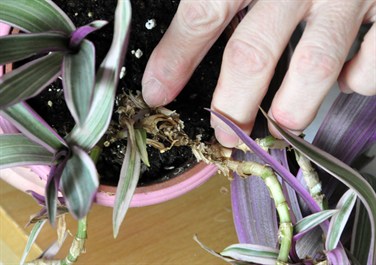Unless you have infinite space for houseplants, they must be cut from time to time to restrict their
size. Many also have potential for exquisite form if you shape and train them.
Bonus: Another kind of cutting, to start
new plants... for friends! Remember you have
enough!
So learn to cut!
Early spring is a great time to do this because longer days have
spurred new growth. Plants will very quickly fill any voids or
follow your lead.
Below: Reader M.O. had to move these hoya plants when she
helped her mother move to a new apartment. The simple way to do
them would have been to cut them back and then re-train them as
spring drives new growth. However, it would take more than one year
to re-frame a window. So in a real labor of love, "We un-twined and
coiled every branch and moved them intact!"


Right: Yes, this hoya would grow back, even if cut hard like
the Tradescantia we use as an example for the rest of this
article.
Below:
Time to thin the new growth that's come after last fall's cutting back of
this old jade. Each of those shoots will be its own big branch
one day and we don't need so many. We clip some out now so the
remainder have all the room and all the plant's resources during
spring's strong growth period.

Cleaned,
then cut to remain the same size
This little spiderwort (Tradescantia 'zebrina') is
as cute on the windowsill over the kitchen sink as it is here on
the work table.
However, it's in need of deadleafing now that new growth is
claiming stored nutrients from older leaves.
Also, we want it to remain a size that fits on the
windowsill. So now as spring spurs its growth we'll ask it to make
new arms rather than reach farther with what it already
has.


Below, right: We didn't notice until we deadleafed that one
branch has been damaged.
Below, left: The growth from that entire shoot is
weak.


Below, right: So we cut it all off, the whole bad stem right
back to its one good sprout .
.
Below: We cut back its better arm, too, because we want new
growth to begin from within the pot. If we leave any of the arm in
place the new growth will begin from its tip.

Seems like a lot to remove? Nope!
Cuttings as a bonus of
cutting

That damaged stem had been growing as a self-made cutting,
disconnected from the plant's root system. The moisture it needed
came via adventitious roots from this portion. Adventitious roots
are roots arising in an unlikely place, such as from stems above
ground.
The small bumps on this stem are very effective adventitious
roots. (See them, above? The white "wart" below the scissor tip
and the longer, brown-er wart the the left of the scissor
tip.) Those roots developed in the moisture of condensation on
the window and metal sill.
So we could make a new plant of this liveliest bit from our
clipping. (It's separated from the chaff, positioned forward
and right in the photo below, right.) It could become a gift
plant.
Just set it into its own pot. Rest it on a slight depression in
the potting mix, anchor it there between a couple of popsicle
sticks and keep it barely moist while its root buds elongate.
There you have it!
Before and after... in a month or two it will have reclaimed
all its former space with healthy new branches, and beg clipping
again.

